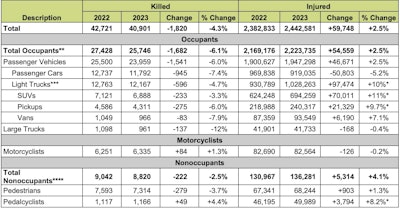Trucking news and briefs for Wednesday, April 9, 2025:
NHTSA: Traffic fatalities estimated to fall below 40,000 for 2024
Traffic fatalities across the United States are trending down, according to recent data released by the National Highway Traffic Safety Administration. What's more, falling at a faster rate are large truck occupant deaths and other fatalities in crashes involving a truck.
The agency this week released its final 2023 traffic crash data and analysis, which found that 1,820 fewer people were killed in motor vehicle traffic crashes on U.S. roads during 2023, a 4.3% decrease from 42,721 in 2022 to 40,901 in 2023. The agency also released its early estimates of traffic fatalities for 2024, projecting that 39,345 people died in traffic crashes, down from the 40,901 fatalities in 2023.
 In its final 2023 traffic crash data and analysis, NHTSA reported a 4.3% decline in traffic fatalities, coupled with a 2.5% increase in injuries.NHTSA
In its final 2023 traffic crash data and analysis, NHTSA reported a 4.3% decline in traffic fatalities, coupled with a 2.5% increase in injuries.NHTSA
The 2024 estimates represent a fall of about 3.8% compared to the 2023 numbers and mark the first time since 2020 that the number of fatalities fell below 40,000. The quarterly fatality declines that began in the second quarter of 2022 also continued, with the fourth quarter of 2024 marking the 11th consecutive quarterly decline in traffic fatalities.

“It’s encouraging to see that traffic fatalities are continuing to fall from their COVID pandemic highs. Total road fatalities, however, remain significantly higher than a decade ago, and America’s traffic fatality rate remains high relative to many peer nations,” NHTSA Chief Counsel Peter Simshauser said. “To reduce fatalities further, USDOT is working closely to partner with the law enforcement community to enhance traffic enforcement on our roads, including speeding, impairment, distraction, and lack of seatbelt use.”
[Related: 'Stop Netradyning me': Can a camera and an app make you a better driver?]
Large truck-specific numbers | While 2024 estimates only show overall fatality numbers, the final 2023 data breaks them down further, revealing that in in 2023, 497 fewer fatalities in crashes involving large trucks led an 8.3% decline. Large truck is defined by NHTSA as commercial and non-commercial trucks with GVWRs over 10,000 pounds. Similarly, large-truck occupant fatalities fell by 137, or 12%.
 Looking at large-truck-specific numbers, truck-involved crashes resulted in 8.3% fewer fatalities and 4.5% fewer injuries in 2023 than 2022.NHTSA
Looking at large-truck-specific numbers, truck-involved crashes resulted in 8.3% fewer fatalities and 4.5% fewer injuries in 2023 than 2022.NHTSA
Among fatalities in traffic crashes involving large trucks in 2023:
- Large-truck occupant fatalities in single-vehicle crashes decreased by 19, a 3.1% decrease from 2022
- Large-truck occupant fatalities in multi-vehicle crashes decreased by 118, a 24% decline from 2022
- Occupants of other vehicles killed decreased by 350, an 8.4% decrease
- Nonoccupants (pedestrians and pedalcyclists) killed decreased fell by 10, a 1.5% decline.
The estimated number of people injured in crashes involving large trucks in 2023 decreased by 4.5% from 2022, bucking the overall trend of people injured in all crashes during the year. NHTSA reported that the estimated number of people injured in 2023 increased by 59,748 to 2.44 million, a 2.5% increase from the 2.38 million people injured in 2022.
NHTSA also analyzed fatality numbers for three behavioral factors -- alcohol-impaired driving, speeding, and restraint use.
Drivers of all vehicle types saw decreases in the number of alcohol-impaired drivers involved in fatal crashes from 2022 to 2023 but for large-truck drivers. Fatalities resulting increased by 19% from 157 fatalities to 187 fatalities in that crash category. The agency did not detail vehicle types in its report on speeding and restraint use.
[Related: FMCSA punts on ELDs' safety effectiveness in Congressional report]
FMCSA extends McKee Foods’ split-sleeper waiver
The Federal Motor Carrier Safety Administration, in a Federal Register notice published Wednesday, has renewed a waiver for McKee Foods that allows the company’s team drivers to take the equivalent of 10 consecutive hours off duty by splitting sleeper berth time into two periods totaling 10 hours, provided neither of the two periods is less than two hours.
Current regulations allow truck drivers to split their 10-hour off-duty period into periods of either 8- and 2-hour breaks, or 7- and 3-hour breaks, as long as driving time before and after each rest period added together does not exceed 11 hours driving and does not violate the 14-hour driving “window” limit. Since 2020, the shorter of the two periods no longer counts against the 14-hour daily on-duty window.
[Related: Significant hours-of-service change: FMCSA's 2020 tweaks to split-sleeper provisions, explained]
McKee Foods’ exemption, which the company has held since 2015, allows its team drivers even more flexibility, giving them the ability to use the split up to 5/5 for the equivalent of 10 hours off-duty (as long as neither of the two periods is less than three hours).
To ensure an equivalent level of safety under the exemption, McKee has instituted some additional safeguards for its drivers:
- Every week, all transportation operations shut down one hour prior to sundown on Friday until one hour after sundown on Saturday, resulting in an automatic minimum 26-hour off-duty home time for all drivers each weekend, in addition to home time during the week.
- All trucks are equipped with speed limiters.
- Drivers continue to use ELDs to track their duty time and hours of service compliance.
- Drive time is reduced from 11 hours to 10 hours.
- Behavior-based event data is monitored from the ELD to enhance safety measures to help reduce the probability of accidents on the road.
Following FMCSA’s renewal, the exemption is now effective through April 20, 2030.
In recent Overdrive polling, nearly 9 in every 10 readers felt maximum split flexibility would be the best split-sleeper option in the hours rules for professional truckers to get better rest.












